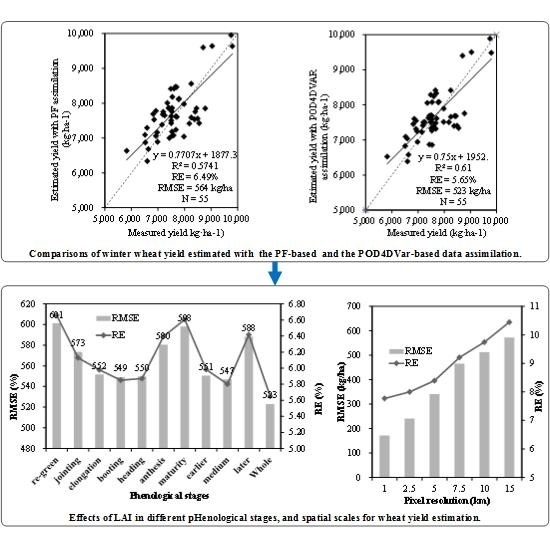Improving Winter Wheat Yield Estimation from the CERES-Wheat Model to Assimilate Leaf Area Index with Different Assimilation Methods and Spatio-Temporal Scales
Abstract
:1. Introduction
2. Materials and Methods
2.1. Study Area
2.2. Data Preparation
2.2.1. Field Observation Data
2.2.2. Remote Sensing Data
2.2.3. Soil, Weather and Crop Information
3. Method
3.1. Crop Growth Model
3.1.1. Description of the Crop Growth Model
3.1.2. Calibration of Crop Growth Model
3.2. LAI Inversion by the PROSAIL Radiative Transfer Model
3.3. Particle Filter Assimilation
3.4. Ensemble-Based Four-Dimensional Variational Data Assimilation
4. Results
4.1. Remotely-Sensed LAI Estimates
4.2. Comparison of Crop Yield Estimates Based on Data Assimilation at the Field Scale
4.3. Assimilation of Remotely-Sensed LAI at the Regional Scale
4.4. Effects of LAI in Different Phenological Stages for Wheat Yield Estimation at the Field Scale
4.5. Effects of LAI in Different Temporal Frequencies for Wheat Yield Estimation at the Regional Scale
4.6. Effects of LAI at Different Spatial Scales for Wheat Yield Estimation
5. Discussion
6. Conclusions
Acknowledgments
Author Contributions
Conflicts of Interest
References
- Rae, A.; Pardey, P. Global food security-introduction. Aust. J. Agric. Resour. Econ. 2014, 58, 499–503. [Google Scholar] [CrossRef]
- Lipper, L.; Thornton, P.; Campbell, B.M.; Baedeker, T.; Braimoh, A.; Bwalya, M.; Caron, P.; Cattaneo, A.; Garrity, D.; Henry, K. Climate-smart agriculture for food security. Nat. Clim. Chang. 2014. [Google Scholar] [CrossRef]
- Zhao, Y.; Chen, S.; Shen, S. Assimilating remote sensing information with crop model using ensemble kalman filter for improving LAI monitoring and yield estimation. Ecol. Model. 2013, 270, 30–42. [Google Scholar] [CrossRef]
- Li, Y.; Zhou, Q.; Zhou, J.; Zhang, G.; Chen, C.; Wang, J. Assimilating remote sensing information into a coupled hydrology-crop growth model to estimate regional maize yield in arid regions. Ecol. Model. 2014, 291, 15–27. [Google Scholar] [CrossRef]
- Huang, J.; Ma, H.; Su, W.; Zhang, X.; Huang, Y.; Fan, J.; Wu, W. Jointly assimilating MODIS LAI and ET products into the swap model for winter wheat yield estimation. IEEE J. Sel. Top. Appl. Earth Obs. Remote Sens. 2015, 8, 4060–4071. [Google Scholar] [CrossRef]
- Huang, J.; Tian, L.; Liang, S.; Ma, H.; Becker-Reshef, I.; Huang, Y.; Su, W.; Zhang, X.; Zhu, D.; Wu, W. Improving winter wheat yield estimation by assimilation of the leaf area index from Landsat Tm and MODIS data into the WOFOST model. Agric. For. Meteorol. 2015, 204, 106–121. [Google Scholar] [CrossRef]
- Fang, H.; Liang, S.; Hoogenboom, G. Integration of MODIS LAI and vegetation index products with the CSM–CERES–Maize model for corn yield estimation. Int. J. Remote Sens. 2011, 32, 1039–1065. [Google Scholar] [CrossRef]
- Doraiswamy, P.C.; Moulin, S.; Cook, P.W.; Stern, A. Crop yield assessment from remote sensing. Photogramm. Eng. Remote Sens. 2003, 69, 665–674. [Google Scholar] [CrossRef]
- Jiang, Z.; Chen, Z.; Chen, J.; Ren, J.; Li, Z.; Sun, L. The estimation of regional crop yield using ensemble-based four-dimensional variational data assimilation. Remote Sens. 2014, 6, 2664–2681. [Google Scholar] [CrossRef]
- De Wit, A.J.W.; van Diepen, C.A. Crop model data assimilation with the ensemble kalman filter for improving regional crop yield forecasts. Agric. For. Meteorol. 2007, 146, 38–56. [Google Scholar] [CrossRef]
- Srivastava, A.K.; Gaiser, T. Simulating biomass accumulation and yield of yam (Dioscorea alata) in the upper ouémé basin (Benin Republic)-I. Compilation of physiological parameters and calibration at the field scale. Field Crop. Res. 2010, 116, 23–29. [Google Scholar] [CrossRef]
- Van der Velde, M.; Wriedt, G.; Bouraoui, F. Estimating irrigation use and effects on maize yield during the 2003 heatwave in France. Agric. Ecosyst. Environ. 2010, 135, 90–97. [Google Scholar] [CrossRef]
- Rinaldi, M.; de Luca, D. Application of EPIC model to assess climate change impact on sorghum in southern Italy. Ital. J. Agron. 2012. [Google Scholar] [CrossRef]
- Confalonieri, R.; Acutis, M.; Bellocchi, G.; Donatelli, M. Multi-metric evaluation of the models warm, cropsyst, and WOFOST for rice. Ecol. Model. 2009, 220, 1395–1410. [Google Scholar] [CrossRef]
- De Wit, A.J.W.; Boogaard, H.L.; van Diepen, C.A. Spatial resolution of precipitation and radiation: The effect on regional crop yield forecasts. Agric. For. Meteorol. 2005, 135, 156–168. [Google Scholar] [CrossRef]
- Wang, J.; Li, X.; Lu, L.; Fang, F. Estimating near future regional corn yields by integrating multi-source observations into a crop growth model. Eur. J. Agron. 2013, 49, 126–140. [Google Scholar] [CrossRef]
- De Wit, A.; Duveiller, G.; Defourny, P. Estimating regional winter wheat yield with WOFOST through the assimilation of green area index retrieved from MODIS observations. Agric. For. Meteorol. 2012, 164, 39–52. [Google Scholar] [CrossRef]
- Vazifedoust, M.; van Dam, J.C.; Bastiaanssen, W.G.M.; Feddes, R.A. Assimilation of satellite data into agrohydrological models to improve crop yield forecasts. Int. J. Remote Sens. 2009, 30, 2523–2545. [Google Scholar] [CrossRef]
- Launay, M.; Guerif, M. Assimilating remote sensing data into a crop model to improve predictive performance for spatial applications. Agric. Ecosyst. Environ. 2005, 111, 321–339. [Google Scholar] [CrossRef]
- Luo, Y.; Ogle, K.; Tucker, C.; Fei, S.; Gao, C.; LaDeau, S.; Clark, J.S.; Schimel, D.S. Ecological forecasting and data assimilation in a data-rich era. Ecol. Appl. 2011, 21, 1429–1442. [Google Scholar] [CrossRef] [PubMed]
- Ma, G.; Huang, J.; Wu, W.; Fan, J.; Zou, J.; Wu, S. Assimilation of MODIS-LAI into the WOFOST model for forecasting regional winter wheat yield. Math. Comput. Model. 2013, 58, 634–643. [Google Scholar] [CrossRef]
- Jiang, Z.W.; Chen, Z.X.; Chen, J.; Liu, J.; Ren, J.Q.; Li, Z.N.; Sun, L.; Li, H. Application of crop model data assimilation with a particle filter for estimating regional winter wheat yields. IEEE J. Sel. Top. Appl. Earth Obs. Remote Sens. 2014, 7, 4422–4431. [Google Scholar] [CrossRef]
- Cheng, Z.; Meng, J.; Wang, Y. Improving spring maize yield estimation at field scale by assimilating time-series HJ-1 CCD data into the WOFOST model using a new method with fast algorithms. Remote Sens. 2016, 8, 303. [Google Scholar] [CrossRef]
- Dong, T.; Liu, J.; Qian, B.; Zhao, T.; Jing, Q.; Geng, X.; Wang, J.; Huffman, T.; Shang, J. Estimating winter wheat biomass by assimilating leaf area index derived from fusion of Landsat-8 and MODIS data. Int. J. Appl. Earth Obs. 2016, 49, 63–74. [Google Scholar] [CrossRef]
- Huang, J.; Sedano, F.; Huang, Y.; Ma, H.; Li, X.; Liang, S.; Tian, L.; Zhang, X.; Fan, J.; Wu, W. Assimilating a synthetic Kalman filter leaf area index series into the WOFOST model to estimate regional winter wheat yield. Agric. For. Meteorol. 2016, 216, 188–202. [Google Scholar] [CrossRef]
- Ines, A.V.M.; Hansen, J.W.; Robertson, A.W. Enhancing the utility of daily GCM rainfall for crop yield prediction. Int. J. Climatol. 2011, 31, 2168–2182. [Google Scholar] [CrossRef]
- Dorigo, W.A.; Zurita-Milla, R.; de Wit, A.J.W.; Brazile, J.; Singh, R.; Schaepman, M.E. A review on reflective remote sensing and data assimilation techniques for enhanced agroecosystem modeling. Int. J. Appl. Earth Obs. 2007, 9, 165–193. [Google Scholar] [CrossRef]
- Ma, Y.; Wang, S.; Zhang, L.; Hou, Y.; Zhuang, L.; He, Y.; Wang, F. Monitoring winter wheat growth in North China by combining a crop model and remote sensing data. Int. J. Appl. Earth Obs. 2008, 10, 426–437. [Google Scholar]
- Powell, M.J.D. An efficient method for finding the minimum of a function of several variables without calculating derivatives. Comput. J. 1964, 7, 155–162. [Google Scholar] [CrossRef]
- Fang, H.; Liang, S.; Hoogenboom, G.; Teasdale, J.; Cavigelli, M. Corn-yield estimation through assimilation of remotely sensed data into the CSM-CERES-Maize model. Int. J. Remote Sens. 2008, 29, 3011–3032. [Google Scholar] [CrossRef]
- Kirkpatrick, S.; Gelatt, C.D.; Vecchi, M.P. Optimization by simulated annealing. Science 1983, 220, 671–680. [Google Scholar] [CrossRef] [PubMed]
- Duan, Q.Y.; Gupta, V.K.; Sorooshian, S. Shuffled complex evolution approach for effective and efficient global minimization. J. Optim. Theory Appl. 1993, 76, 501–521. [Google Scholar] [CrossRef]
- Dente, L.; Satalino, G.; Mattia, F.; Rinaldi, M. Assimilation of leaf area index derived from ASAR and MERIS data into CERES-Wheat model to map wheat yield. Remote Sens. Environ. 2008, 112, 1395–1407. [Google Scholar] [CrossRef]
- Sabater, J.M.; Rüdiger, C.; Calvet, J.C.; Fritz, N.; Jarlan, L.; Kerr, Y. Joint assimilation of surface soil moisture and LAI observations into a land surface model. Agric. For. Meteorol. 2008, 148, 1362–1373. [Google Scholar] [CrossRef] [Green Version]
- Ma, H.; Huang, J.; Zhu, D.; Liu, J.; Su, W.; Zhang, C.; Fan, J. Estimating regional winter wheat yield by assimilation of time series of HJ-1 CCD NDVI into WOFOST–ACRM model with ensemble kalman filter. Math. Comput. Model. 2013, 58, 759–770. [Google Scholar] [CrossRef]
- Li, R.; Li, C.; Dong, Y.; LIU, F.; Wang, J.; Yang, X.; Pan, Y. Assimilation of remote sensing and crop model for LAI estimation based on ensemble kaiman filter. Agric. Sci. Chin. 2011, 10, 1595–1602. [Google Scholar] [CrossRef]
- Evensen, G. The ensemble kalman filter: Theoretical formulation and practical implementation. Ocean Dyn. 2003, 53, 343–367. [Google Scholar] [CrossRef]
- Li, Z.; Zhao, L.; Fu, Z. Estimating net radiation flux in the tibetan plateau by assimilating MODIS LST products with an ensemble kalman filter and particle filter. Int. J. Appl. Earth Obs. 2012, 19, 1–11. [Google Scholar] [CrossRef]
- Arulampalam, M.S.; Maskell, S.; Gordon, N.; Clapp, T. A tutorial on particle filters for online nonlinear/non-Gaussian Bayesian tracking. IEEE Trans. Signal Proc. 2002, 50, 174–188. [Google Scholar] [CrossRef]
- Moore, A.M.; Arango, H.G.; Broquet, G.; Powell, B.S.; Weaver, A.T.; Zavala-Garay, J. The regional ocean modeling system (ROMS) 4-dimensional variational data assimilation systems part I—System overview and formulation. Prog. Oceanogr. 2011, 91, 34–49. [Google Scholar] [CrossRef]
- Curnel, Y.; de Wit, A.J.W.; Duveiller, G.; Defourny, P. Potential performances of remotely sensed LAI assimilation in WOFOST model based on an OSS experiment. Agric. For. Meteorol. 2011, 151, 1843–1855. [Google Scholar] [CrossRef]
- Tian, X.; Xie, Z.; Sun, Q. A pod-based ensemble four-dimensional variational assimilation method. Tellus A 2011, 63, 805–816. [Google Scholar] [CrossRef]
- Tian, X.; Xie, Z.; Dai, A.; Shi, C.; Jia, B.; Chen, F.; Yang, K. A dual-pass variational data assimilation framework for estimating soil moisture profiles from AMSR-E microwave brightness temperature. J. Geophys. Res. 2009. [Google Scholar] [CrossRef]
- Moradkhani, H.; De Chant, C.M.; Sorooshian, S. Evolution of ensemble data assimilation for uncertainty quantification using the particle filter-markov chain Monte Carlo method. Water Resour. Res. 2012. [Google Scholar] [CrossRef]
- Leisenring, M.; Moradkhani, H. Analyzing the uncertainty of suspended sediment load prediction using sequential data assimilation. J. Hydrol. 2012, 468, 268–282. [Google Scholar] [CrossRef]
- Nagarajan, K.; Judge, J.; Graham, W.D.; Monsivais-Huertero, A. Particle filter-based assimilation algorithms for improved estimation of root-zone soil moisture under dynamic vegetation conditions. Adv. Water Resour. 2011, 34, 433–447. [Google Scholar] [CrossRef]
- Leisenring, M.; Moradkhani, H. Snow water equivalent prediction using Bayesian data assimilation methods. Stoch. Environ. Res. Risk Assess. 2011, 25, 253–270. [Google Scholar] [CrossRef]
- Montzka, C.; Moradkhani, H.; Weihermueller, L.; Franssen, H.H.; Canty, M.; Vereecken, H. Hydraulic parameter estimation by remotely-sensed top soil moisture observations with the particle filter. J. Hydrol. 2011, 399, 410–421. [Google Scholar] [CrossRef]
- Chen, Y.; Cournède, P.H. Data assimilation to reduce uncertainty of crop model prediction with convolution particle filtering. Ecol. Model. 2014, 290, 165–177. [Google Scholar] [CrossRef]
- Cao, Y.; Zhu, J.; Navon, I.M.; Luo, Z. A reduced-order approach to four-dimensional variational data assimilation using proper orthogonal decomposition. Int. J. Numer. Methods Fluids 2007, 53, 1571–1583. [Google Scholar] [CrossRef]
- Tian, X.; Xie, Z. Effects of sample density on the assimilation performance of an explicit four-dimensional variational data assimilation method. Sci. China Earth Sci. 2009, 52, 1849–1856. [Google Scholar] [CrossRef]
- Hansen, J.W.; Challinor, A.; Ines, A.; Wheeler, T.; Moron, V. Translating climate forecasts into agricultural terms: Advances and challenges. Clim. Res. 2007, 33, 27–41. [Google Scholar] [CrossRef]
- Ines, A.V.M.; Das, N.N.; Hansen, J.W.; Njoku, E.G. Assimilation of remotely sensed soil moisture and vegetation with a crop simulation model for maize yield prediction. Remote Sens. Environ. 2013, 138, 149–164. [Google Scholar] [CrossRef]
- Claverie, M.; Demarez, V.; Duchemin, B.; Hagolle, O.; Ducrot, D.; Marais-Sicre, C.; Dejoux, J.; Huc, M.; Keravec, P.; Béziat, P.; et al. Maize and sunflower biomass estimation in southwest france using high spatial and temporal resolution remote sensing data. Remote Sens. Environ. 2012, 124, 844–857. [Google Scholar] [CrossRef] [Green Version]
- Plummer, S.; Arino, O.; Ranera, F.; Tansey, K.; Chen, J.; Dedieu, G.; Eva, H.; Piccolini, I.; Leigh, R.; Borstlap, G.; et al. The globcarbon initiative—Global biophysical products for terrestrial carbon studies. In Proceedings of the 2007 IEEE International Geoscience and Remote Sensing Symposium, Barcelona, Spain, 23–28 July 2007.
- Champeaux, J.L.; Masson, V.; Chauvin, R. Ecoclimap: A global database of land surface parameters at 1 km resolution. Meteorol. Appl. 2005, 12, 29–32. [Google Scholar] [CrossRef]
- Yang, W.; Tan, B.; Huang, D.; Rautiainen, M.; Shabanov, N.V.; Wang, Y.; Privette, J.L.; Huemmrich, K.F.; Fensholt, R.; Sandholt, I.; et al. MODIS leaf area index products: from validation to algorithm improvement. IEEE Trans. Geosci. Remote. 2006, 44, 1885–1898. [Google Scholar] [CrossRef]
- Jones, J.W.; Hoogenboom, G.; Porter, C.H.; Boote, K.J.; Batchelor, W.D.; Hunt, L.A.; Wilkens, P.W.; Singh, U.; Gijsman, A.J.; Ritchie, J.T. The DSSAT cropping system model. Eur. J. Agron. 2003, 18, 235–265. [Google Scholar] [CrossRef]
- LI-COR Inc. LAI-2200 Plant Canopy Analyzer, Introduction Manual; LI-COR Inc.: Lincoln, NE, USA, 2010. [Google Scholar]
- Shi, X.Z.; Yu, D.S.; Warner, E.D.; Sun, W.X.; Petersen, G.W.; Gong, Z.T.; Lin, H. Cross-reference system for translating between genetic soil classification of china and soil taxonomy. Soil Sci. Soc. Am. J. 2006, 70, 78–83. [Google Scholar] [CrossRef]
- Shi, X.Z.; Yu, D.S.; Warner, E.D.; Pan, X.Z.; Petersen, G.W.; Gong, Z.G.; Weindorf, D.C. Soil database of 1:1,000,000 digital soil survey and reference system of the Chinese genetic soil classification system. Soil Surv. Horiz. 2004, 45, 129–136. [Google Scholar] [CrossRef]
- Ding, D. Soil Species of Hebei Province; Hebei Science and Technology Press: Shijiazhuang, China, 1992. [Google Scholar]
- Al-Sadah, F.H.; Ragab, F.M. Study of global daily solar radiation and its relation to sunshine duration in bahrain. Sol. Energy 1991, 47, 115–119. [Google Scholar] [CrossRef]
- Allen, R.G.; Pereira, L.S.; Raes, D.; Smith, M. Crop Evapotranspiration: Guidelines for Computing Crop Water Requirements; FAO Irrigation and Drainage Paper No. 56; FAO: Rome, Italy, 1998. [Google Scholar]
- Hutchinson, M.F. ANUSPLIN Version 4.37 User Guide. Available online: http://fennerschool.anu.edu.au/files/anusplin437.pdf (accessed on 18 July 2007).
- Singh, A.K.; Tripathy, R.; Chopra, U.K. Evaluation of CERES-Wheat and CropSyst models for water-nitrogen interactions in wheat crop. Agric. Water Manag. 2008, 95, 776–786. [Google Scholar] [CrossRef]
- Dettori, M.; Cesaraccio, C.; Motroni, A.; Spano, D.; Duce, P. Using CERES-Wheat to simulate durum wheat production and phenology in southern Sardinia, Italy. Field Crop. Res. 2011, 120, 179–188. [Google Scholar] [CrossRef]
- Nearing, G.S.; Crow, W.T.; Thorp, K.R.; Moran, M.S.; Reichle, R.H.; Gupta, H.V. Assimilating remote sensing observations of leaf area index and soil moisture for wheat yield estimates: An observing system simulation experiment. Water Resour. Res. 2012, 48, 213–223. [Google Scholar] [CrossRef]
- Saltelli, A.; Tarantola, S.; Chan, K. A quantitative model-independent method for global sensitivity analysis of model output. Technometrics 1999, 41, 39–56. [Google Scholar] [CrossRef]
- Pasolli, L.; Asam, S.; Castelli, M.; Bruzzone, L.; Wohlfahrt, G.; Zebisch, M.; Notarnicola, C. Retrieval of leaf area index in mountain grasslands in the alps from MODIS satellite imagery. Remote Sens. Environ. 2015, 165, 159–174. [Google Scholar] [CrossRef]
- Darvishzadeh, R.; Atzberger, C.; Skidmore, A.; Schlerf, M. Mapping grassland leaf area index with airborne hyperspectral imagery: A comparison study of statistical approaches and inversion of radiative transfer models. ISPRS J. Photogramm. 2011, 66, 894–906. [Google Scholar] [CrossRef]
- Darvishzadeh, R.; Skidmore, A.; Schlerf, M.; Atzberger, C. Inversion of a radiative transfer model for estimating vegetation LAI and chlorophyll in a heterogeneous grassland. Remote Sens. Environ. 2008, 112, 2592–2604. [Google Scholar] [CrossRef]
- Richter, K.; Atzberger, C.; Vuolo, F.; D’Urso, G. Evaluation of sentinel-2 spectral sampling for radiative transfer model based LAI estimation of wheat, sugar beet, and maize. IEEE J. Sel. Top. Appl. Earth Obs. Remote Sens. 2011, 4, 458–464. [Google Scholar] [CrossRef]
- Nigam, R.; Bhattacharya, B.K.; Vyas, S.; Oza, M.P. Retrieval of wheat leaf area index from awifs multispectral data using canopy radiative transfer simulation. Int. J. Appl. Earth Obs. 2014, 32, 173–185. [Google Scholar] [CrossRef]
- Duan, S.; Li, Z.; Wu, H.; Tang, B.; Ma, L.; Zhao, E.; Li, C. Inversion of the prosail model to estimate leaf area index of maize, potato, and sunflower fields from unmanned aerial vehicle hyperspectral data. Int. J. Appl. Earth Obs. 2014, 26, 12–20. [Google Scholar] [CrossRef]
- Darvishzadeh, R.; Matkan, A.A.; Dashti Ahangar, A. Inversion of a radiative transfer model for estimation of rice canopy chlorophyll content using a lookup-table approach. IEEE J. Sel. Top. Appl. Earth Obs. Remote Sens. 2012, 5, 1222–1230. [Google Scholar] [CrossRef]
- Dorigo, W.A. Improving the robustness of cotton status characterisation by radiative transfer model inversion of multi-angular chris/proba data. IEEE J. Sel. Top. Appl. Earth Obs. Remote Sens. 2012, 5, 18–29. [Google Scholar] [CrossRef]
- Aplin, P. Image analysis, classification and change detection in remote sensing, with algorithms for envi/idl. Int. J. Geogr. Inf. Sci. 2009, 23, 129–130. [Google Scholar]
- Savitzky, A.; Golay, M.J.E. Smoothing and differentiation of data by simplified least squares procedures. Anal. Chem. 1964, 36, 1627–1639. [Google Scholar] [CrossRef]
- Li, H.; Chen, Z.; Wu, W.; Jiang, Z.; Liu, B.; Hasi, T. Crop model data assimilation with particle filter for yield prediction using leaf area index of different temporal scales. In Proceedings of the Fourth International Conference on Agro-Geoinformatics, Istanbul, Turkey, 20–24 July 2015.
- Tian, X.; Xie, Z.; Dai, A. An ensemble-based explicit four-dimensional variational assimilation method. J. Geophys. Res. 2008, 113, 6089. [Google Scholar] [CrossRef]
- Boneau, C.A. The effects of violations of assumptions underlying the t test. Psychol. Bull. 1960, 57, 49–64. [Google Scholar] [CrossRef] [PubMed]
- Snyder, C.; Bengtsson, T.; Bickel, P.; Anderson, J. Obstacles to high-dimensional particle filtering. Mon. Weather Rev. 2008, 136, 4629–4640. [Google Scholar] [CrossRef]





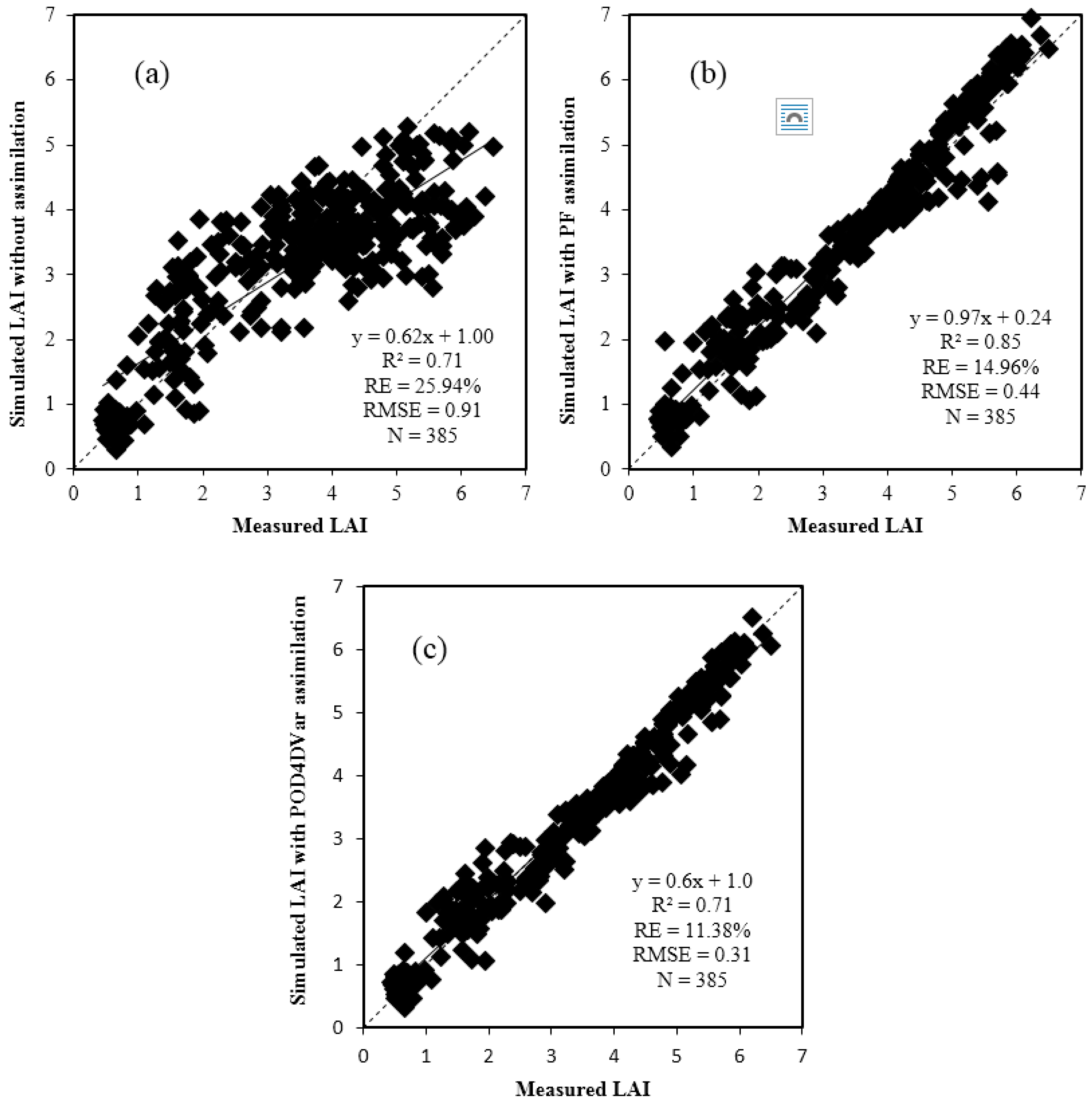
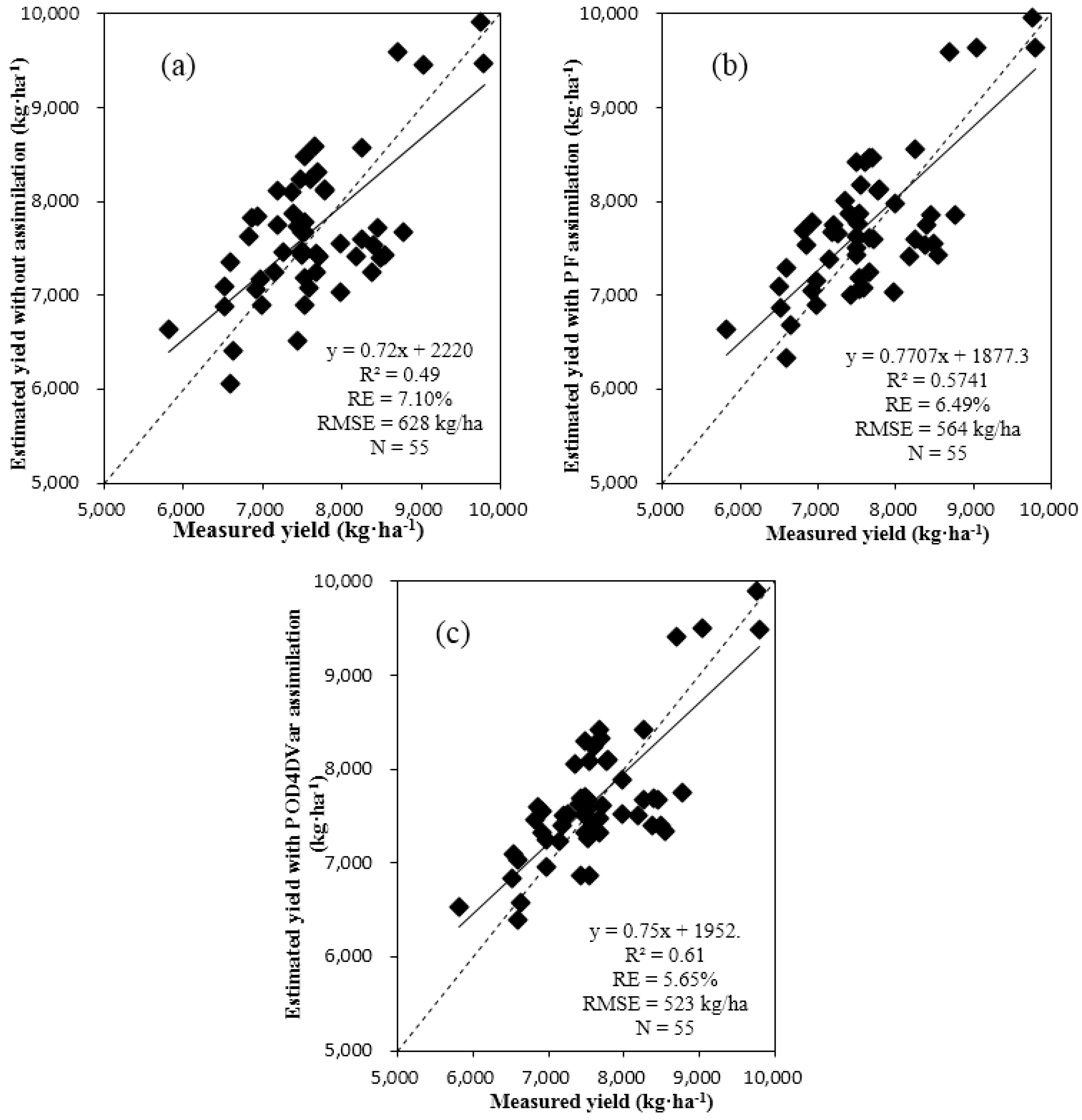
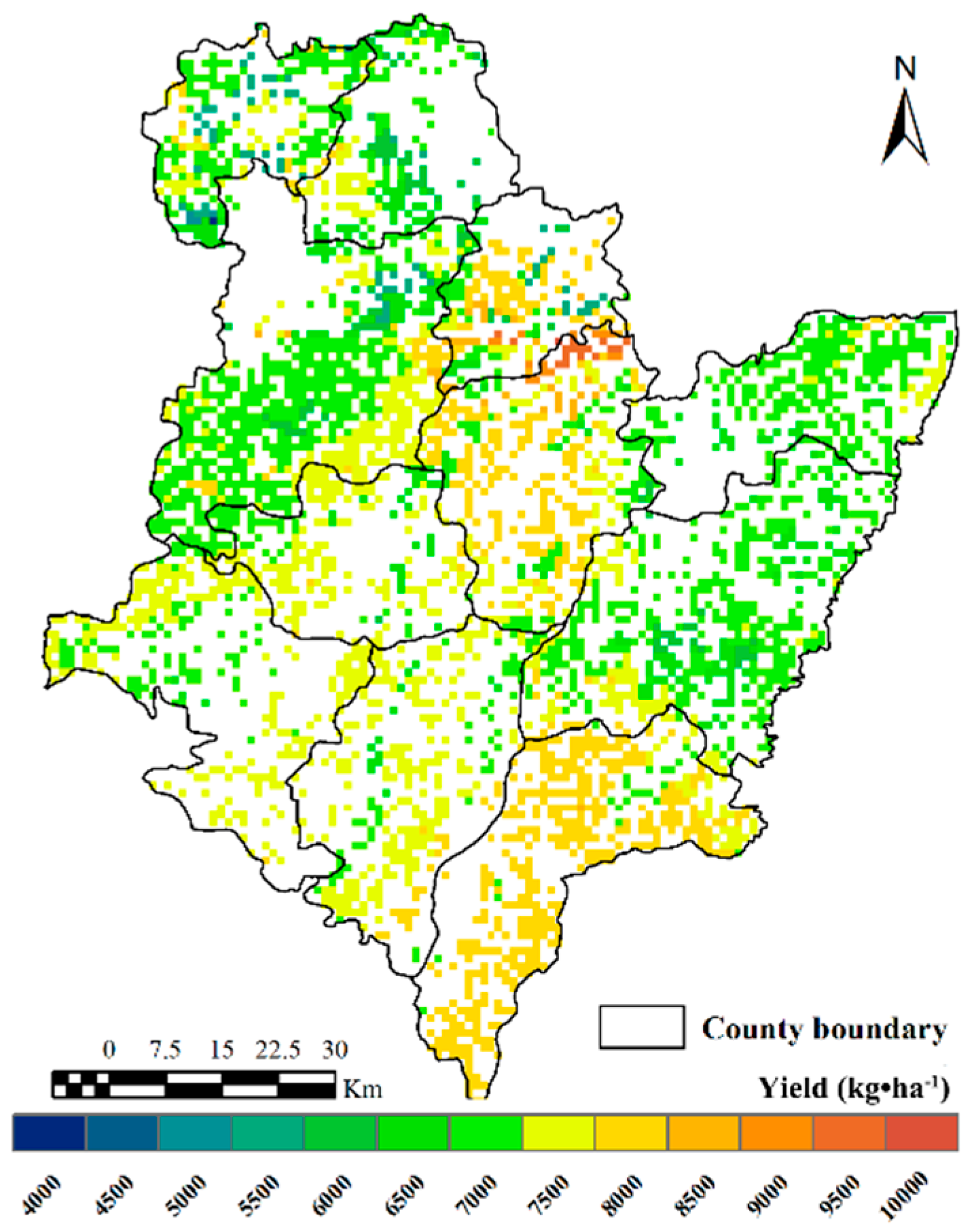
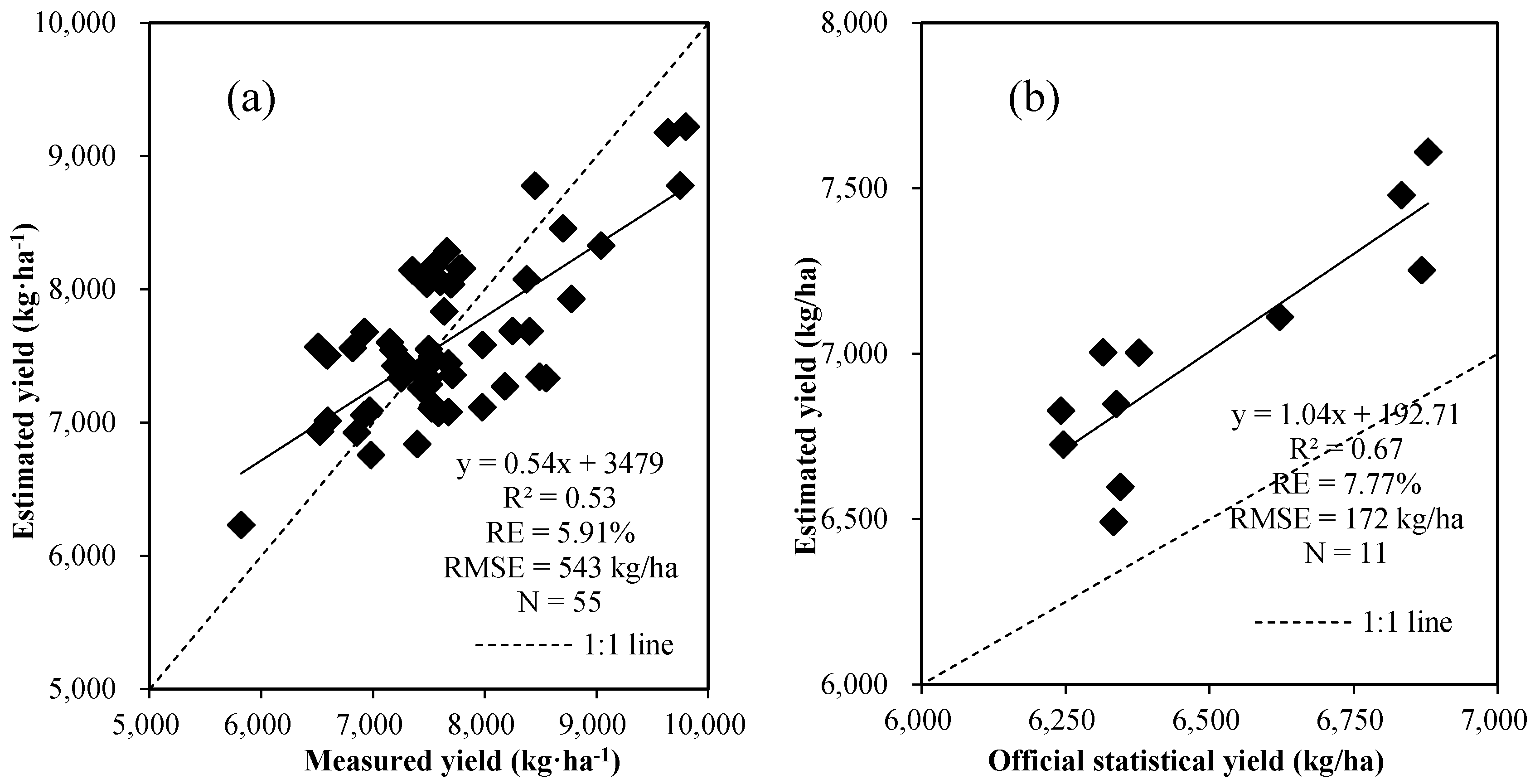



| Sensor | Band | Wavelength Range (μm) | Radiometric Resolution (bit) | Spatial Resolution (m) | Swath (km) | Revisit Period (days) |
|---|---|---|---|---|---|---|
| GF-1 WFV | Blue (1) | 0.450–0.520 | 10 | 16 | 200 (1CCD) 800 (4CCD) | 4 |
| Green (2) | 0.520–0.590 | |||||
| Red (3) | 0.630–0.690 | |||||
| Nir (4) | 0.770–0.890 | |||||
| HJ-1 CCD | Blue (1) | 0.430–0.520 | 8 | 30 | 360 (1CCD) 720 (2CCD) | 4 |
| Green (2) | 0.520–0.600 | |||||
| Red (3) | 0.630–0.690 | |||||
| Nir (4) | 0.760–0.900 | |||||
| Landsat-8 OLI | Blue (2) | 0.450–0.515 | 16 | 30 | 170 × 185 | 16 |
| Green (3) | 0.525–0.600 | |||||
| Red (4) | 0.630–0.680 | |||||
| Nir (5) | 0.845–0.885 |
| Data | Sensor | Time UTC | θsun | ϕsun | θSensor | ϕSensor | |
|---|---|---|---|---|---|---|---|
| 1 | 4 March 2014 | HJ-1B CCD2 | 01 h 58 min | 55.97 | 315.70 | 12.75 | 97.00 |
| 2 | 23 March 2014 | HJ-1B CCD2 | 01 h 45 min | 49.80 | 310.44 | 32.00 | 97.00 |
| 3 | 3 April 2014 | GF-1 WFV4 | 03 h 42 min | 55.67 | 162.79 | 63.44 | 285.08 |
| 4 | 4 April 2014 | HJ-1B CCD2 | 01 h 55 min | 45.97 | 306.82 | 15.00 | 98.00 |
| 5 | 8 April 2014 | HJ-1B CCD2 | 01 h 58 min | 44.76 | 305.55 | 12.70 | 98.00 |
| 6 | 13 April 2014 | Landsat-8 OLI | 02 h 54 min | 34.85 | 141.18 | 0 | 90 |
| 7 | 14 April 2014 | GF-1 WFV1 | 03 h 12 min | 58.12 | 149.88 | 63.41 | 101.48 |
| 8 | 29 April 2014 | Landsat-8 OLI | 02 h 54 min | 38.09 | 136.81 | 0 | 90 |
| 9 | 5 May 2014 | HJ-1B CCD2 | 01 h 54 min | 37.93 | 296.64 | 22.0 | 98.00 |
| 10 | 7 May 2014 | HJ-1A CCD2 | 01 h 55 min | 37.05 | 296.71 | 24.00 | 97.00 |
| 11 | 12 May 2014 | HJ-1A CCD1 | 02 h 23 min | 33.21 | 298.83 | 13.00 | 283.00 |
| 12 | 15 May 2014 | Landsat-8 OLI | 02 h 54 min | 25.33 | 131.37 | 0 | 90 |
| 13 | 17 May 2014 | GF-1 WFV2 | 03 h 18 min | 68.51 | 144.80 | 74.43 | 101.31 |
| 14 | 21 May 2014 | GF-1 WFV1 | 03 h 16 min | 68.27 | 141.16 | 63.39 | 101.47 |
| 15 | 29 May 2014 | HJ-1B CCD1 | 02 h10 min | 31.14 | 293.58 | 12.40 | 282.00 |
| 16 | 5 June 2014 | HJ-1B CCD2 | 01 h 50 min | 33.43 | 286.39 | 13.30 | 98.00 |
| Parameters | Descriptions | Calibrated Values | Ranges | Units |
|---|---|---|---|---|
| Crop Initial Condition Parameters | ||||
| PDATE | Sowing date | 282 | 275–290 | day of year |
| PPOP | Sowing population | 450 | 200–500 | plant/m2 |
| IDATE & FDATE 1 | Irrigation and fertilization date 1 | 90 | 80–110 | day of year |
| IDATE 2 | Irrigation date 2 | 130 | 111–140 | day of year |
| IRVAL | Irrigation amount | 80 | 60–150 | mm |
| FAMN | Nitrogen fertilizer at sowing | 120 | 0–300 | kg·ha−1 |
| FAMN1 | Nitrogen fertilizer at date 1 | 170 | 60–280 | kg·ha−1 |
| Cultivar parameters | ||||
| P1V | Vernalization duration, which is the number of days of optimum temperature necessary for vernalization | 50 | 0–60 | days |
| P1D | Photoperiod response, which is the percent reduction in photosynthesis for every 10 h reduction in the photoperiod | 55 | 0–200 | % |
| P5 | Grain-filling phase duration in growing degree days | 559 | 100–1000 | °C … days |
| G1 | Number of kernels per unit plant weight | 35 | 10–50 | number/g |
| G2 | Standard kernel size | 40 | 10–80 | mg |
| G3 | Standard tiller weight | 1 | 1–8 | g |
| PHINT | Photoperiod interval between leaf tip appearances | 95 | 30–150 | °C … days |
| Variables | Abbr. | Unit | Min | Mean | Max | Std.Dev | Distribution |
|---|---|---|---|---|---|---|---|
| Leaf structural parameter | Ni | - | 1.2 | 1.5 | 1.8 | 0.3 | Gauss |
| Chlorophyll a + b content | Cab | μg·cm−2 | 30 | 50 | 70 | 7.5 | Gauss |
| Equivalent water thickness | Cw | cm | 0.60 | 0.75 | 0.85 | - | Uniform |
| Dry matter content | Cm | g·cm−2 | 0.003 | 0.007 | 0.011 | 0.002 | Gauss |
| Brown pigments content | Cbp | μg·cm−2 | 0 | 0 | 0.2 | 0.3 | Gauss |
| Leaf area index | LAI | - | 0 | 5 | 8 | - | Uniform |
| Average leaf inclination angle | ALIA | ° | 30 | 60 | 80 | 5 | Gauss |
| Hot spot parameter | hspot | - | 0.1 | 0.3 | 0.5 | 0.2 | Gauss |
| Soil brightness parameter | psoil | - | 0.5 | 1.2 | 3.5 | 2.0 | Gauss |
| Fraction of diffuse incoming solar radiation | skyl | % | - | 10 | - | - | Fixed |
| Solar zenith angle | tts | ° | 25 | 46 | 70 | - | Fixed |
| View zenith angle | tto | ° | 0 | 32 | 80 | - | Fixed |
| Relative azimuth angle | psi | ° | −120 | 90 | 120 | - | Fixed |
| Green-up | Jointing | Elongation | Booting | Heading | Anthesis | Maturity | |
|---|---|---|---|---|---|---|---|
| R2 | 0.66 | 0.54 | 0.83 | 0.74 | 0.64 | 0.66 | 0.78 |
| RE (%) | 12.18 | 9.33 | 9.74 | 8.97 | 7.75 | 9.37 | 8.77 |
| RMSE | 0.09 | 0.19 | 0.46 | 0.51 | 0.45 | 0.44 | 0.32 |
© 2017 by the authors. Licensee MDPI, Basel, Switzerland. This article is an open access article distributed under the terms and conditions of the Creative Commons Attribution (CC BY) license ( http://creativecommons.org/licenses/by/4.0/).
Share and Cite
Li, H.; Chen, Z.; Liu, G.; Jiang, Z.; Huang, C. Improving Winter Wheat Yield Estimation from the CERES-Wheat Model to Assimilate Leaf Area Index with Different Assimilation Methods and Spatio-Temporal Scales. Remote Sens. 2017, 9, 190. https://doi.org/10.3390/rs9030190
Li H, Chen Z, Liu G, Jiang Z, Huang C. Improving Winter Wheat Yield Estimation from the CERES-Wheat Model to Assimilate Leaf Area Index with Different Assimilation Methods and Spatio-Temporal Scales. Remote Sensing. 2017; 9(3):190. https://doi.org/10.3390/rs9030190
Chicago/Turabian StyleLi, He, Zhongxin Chen, Gaohuan Liu, Zhiwei Jiang, and Chong Huang. 2017. "Improving Winter Wheat Yield Estimation from the CERES-Wheat Model to Assimilate Leaf Area Index with Different Assimilation Methods and Spatio-Temporal Scales" Remote Sensing 9, no. 3: 190. https://doi.org/10.3390/rs9030190




